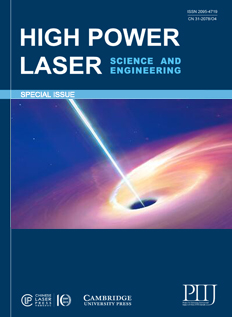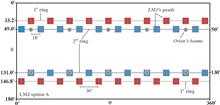
Editor(s):
Year: 2014
Status: Published
The use of the Laser MegaJoule facility within the shock ignition scheme has been considered. In the first part of the study, one-dimensional hydrodynamic calculations were performed for an inertial confinement fusion capsule in the context of the shock ignition scheme providing the energy gain and an estimation of the increase of the peak power due to the reduction of the photon penetration expected during the high-intensity spike pulse. In the second part, we considered a Laser MegaJoule configuration consisting of 176 laser beams that have been grouped providing two different irradiation schemes. In this configuration the maximum available energy and power are 1.3 MJ and 440 TW. Optimization of the laser–capsule parameters that minimize the irradiation non-uniformity during the first few ns of the foot pulse has been performed. The calculations take into account the specific elliptical laser intensity profile provided at the Laser MegaJoule and the expected beam uncertainties. A significant improvement of the illumination uniformity provided by the polar direct drive technique has been demonstrated. Three-dimensional hydrodynamic calculations have been performed in order to analyse the magnitude of the azimuthal component of the irradiation that is neglected in twodimensional hydrodynamic simulations.
We present the results of performance modeling of a diode-pumped solid-state HiLASE laser designed for use in inertial fusion energy power plants. The main amplifier concept is based on a He-gas-cooled multi-slab architecture similar to that employed in Mercury laser system. Our modeling quantifies the reduction of thermally induced phase aberrations and average depolarization in Yb3C:YAG slabs by a combination of helium cryogenic cooling and properly designed (doping/width) cladding materials.
The laser system PALS, as a driver of a broad-beam ion source, delivered deuterons which generated neutrons with energies higher than 14 MeV through the 7Li(d, n)8Be reaction. Deuterons with sub-MeV energy were accelerated from the front surface of a massive CD2 target in the backward direction with respect to the laser beam vector. Simultaneously, neutrons were emitted from the primary CD2 target and a secondary LiF catcher. The total maximum measured neutron yield from 2D(d, n)3He, 7Li(d, n)8Be, 12C(d, n)13N reactions was ~3.5(±0.5) × 108 neutrons/shot.
This paper reviews the different challenges that are encountered in the delivery of high power lasers as drivers for fusion energy. We will focus on diode-pumped solid-state lasers and we will highlight some of the main recent achievements when using ytterbium, cryogenic cooling and ceramic gain media. Apart from some existing fusion facilities and some military applications of diode-pumped solid-state lasers, we will show that diode-pumped solid-state lasers are scalable to inertial fusion energy (IFE)’s facility level and that the all-fiber laser scheme is very promising.
To establish the mechanism of surface change in a continuous polishing system, an ideal mathematical model is built based on Winkler’s hypothesis and the Preston equation. The basic features of the model are the change rates in the surface peak–valley (PV) values of the workpiece, conditioning disk and pitch lap, rather than the specific surface shapes. In addition, an equilibrium state exists in the system, indicating that the surface change rates are all zero. Under equilibrium, the surface of the lap could remain flat, and it is insensitive to the surface error of the workpiece. These characteristics lay the theoretical foundations for high-efficiency and high-precision polishing. The methods to obtain an equilibrium state with flat surfaces are then proposed and confirmed experimentally. High-precision surfaces better than λ/10 (λ=632.8 nm) are consistently produced experimentally.
As our understanding of the environmental impact of fossil fuel based energy production increases, it is becoming clear that the world needs a new energy solution to meet the challenges of the future. A transformation is required in the energy market to meet the need for low carbon, sustainable, affordable generation matched with security of supply. In the short term, an increasing contribution from renewable sources may provide a solution in some locations. In the longer term, low carbon, sustainable solutions must be developed to meet base load energy demand, if the world is to avoid an ever increasing energy gap and the attendant political instabilities. Laser-driven inertial fusion energy (IFE) may offer such a solution.
The role of the coronal electron plasma temperature for shock-ignition conditions is analysed with respect to the dominant parametric processes: stimulated Brillouin scattering, stimulated Raman scattering, two-plasmon decay (TPD), Langmuir decay instability (LDI) and cavitation. TPD instability and cavitation are sensitive to the electron temperature. At the same time the reflectivity and high-energy electron production are strongly affected. For low plasma temperatures the LDI plays a dominant role in the TPD saturation. An understanding of laser–plasma interaction in the context of shock ignition is an important issue due to the localization of energy deposition by collective effects and hot electron production. This in turn can have consequences for the compression phase and the resulting gain factor of the implosion phase.















